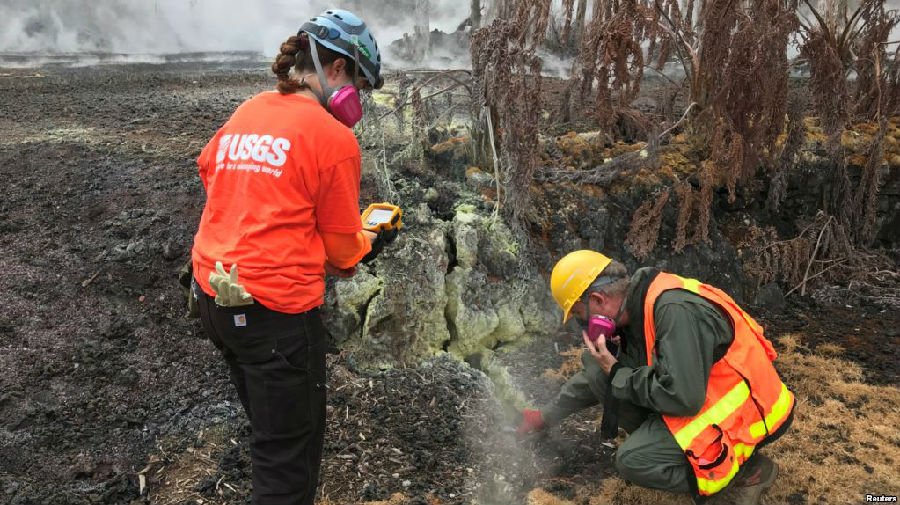(单词翻译:单击)
听力文本
Wearing heavy cotton clothing, head protection and a device to help her breathe, Jessica Ball recently spent the night observing lava coming out of Hawaii's Kilauea volcano.
Ball is a researcher with the United States Geological Survey, the agency which studies the country's land and natural resources.
She was at "fissure 8," one of at least 22 holes that have opened around the Kilauea volcano in the past two months.
Rock from deep inside the volcano is so hot that it has become a liquid.
The liquid, known as lava, began flowing from the openings in early May.
At fissure 8, the lava shot up as high as 45 meters in the air before slowly heading for the Pacific Ocean a few kilometers away.
"The volcano is doing what it wants to," Ball told the Reuters news service.
"We're reminded what it's like to deal with the force of nature."
Scientists have been in the area of the volcanic activity measuring the eruptions 24 hours a day, seven days a week since Kilauea first exploded.
They are a mix of U.S. Geological Survey experts, University of Hawaii researchers and trained volunteers.
They work six-to-eight-hour periods in teams of two to five.
The intense heat will melt any non-natural clothing materials, so the team members can only wear heavy cotton.
Gloves protect their hands from sharp volcanic rock and glass.
Head coverings protect against falling lava stones, and breathing devices protect against gases, like sulfur, coming from the openings.
Some geologists have died studying active volcanoes.
David Alexander Johnston was a volcano expert with the U.S. Geological Survey.
He was killed by the 1980 eruption of Mount St. Helens in Washington state.
Harry Glicken was another American expert who worked with French researchers Katia and Maurice Krafft.
All three were killed while studying Mount Unzen in Japan.
Jessica Ball completed her studies at the State University of New York at Buffalo, located near the Canadian border.
She compares Kilauea's eruptions to Niagara Falls, which is near her former school.
"It gives you the same feeling of power and force," she said.
Kilauea has been erupting almost without stopping since 1983.
It is one of the world's most closely observed volcanoes.

Most of these observations took place at the Hawaiian Volcano Observatory on Kilauea's highest point, from which researchers have now had to flee.
But the latest eruption is one of the biggest and could provide scientists with a lot of new information.
Ball and her fellow researchers are studying how magma - the molten rock beneath the earth - flows through a series of tubes under Kilauea before being sent flying in to the air.
Once magma passes through the earth's surface, it is considered lava.
Ball says they want to learn what warning signs may exist for future eruptions to better protect Hawaii's communities.
Janet Snyder is with the local government where Kilauea is located.
She notes that steam or ash erupt from the volcano's highest point almost every day.
But the latest eruption has destroyed over 1,000 structures and forced 2,000 people to flee the area.
Scientists had thought the steam explosions resulted from lava at the highest point dropping back down through the volcano into groundwater.
This was based on Kilauea's 1924 eruption, to which the current one is most often compared.
Michael Poland is the scientist-in-charge at Yellowstone Volcano Observatory.
He says the explosions this time have released lots of sulfur dioxide gas.
This leads scientists to believe magma is involved.
Hundreds of small earthquakes caused by the eruptions have damaged the structure of the Hawaiian Volcano Observatory.
So Poland and other scientists pulled equipment and records out of the building and moved them to the University of Hawaii in Hilo.
The records included scientific information and photos that are more than 100 years old, Poland says.
"These materials are invaluable to someone who says, ‘I have this new idea, and I want to test it using past data,'" noted Poland.
The recent eruption is now Kilauea's second longest eruption on record.
The only longer one was in 1955.
But Jessica Ball suggests this eruption offers far better chances for research than earlier events.
"We've got much better instruments and we've got longer to collect the data," she said.
I'm Anna Mateo. And I'm Pete Musto.
重点解析
1. a researcher with (institution) (某研究机构)的研究员
Rena Subotnik, a researcher with the American Psychological Association, has studied children's progression into adult creative careers.
美国心理协会丽娜·萨波尼克研究员研究过关于人从孩子到成年人这个过程中创造力的成长情况。
2. head for 朝……去
And I zip my pants up in front of them, and I head for the door.
然后我在他们面前把裤拉链拉上,朝门口走去。
3. be reminded that 被提醒
Developers are reminded that the GAE Go environment is still experimental, so it is wise not to start writing commercial applications yet.
Google提醒开发者,GAE的Go环境还处于试验阶段,所以最好先不要编写商业化的应用程序。
4. died doing sth. 为……而死
He who died fighting for his country is the most honourable and glorious among the dead.
为何卫国家而战死者,是死者中最高尚,最光荣的。
5. result from 由……产生的
A sizeable proportion of the profits that resulted from all this activity was then handed out to employees in the form of wages and bonuses.
这些行为中产生的相当大一部分利润,以工资和奖金的形式发给职工。
6. on record 有文献记载以来
He said the weather was beyond our control, noting that last summer was one of the hottest on record.
他说我们对天气无能为力,并提到去年夏天曾是有文献记载以来最热的。
参考译文
不久前,杰西卡·鲍尔(Jessica Ball)身穿厚重的棉衣,头戴保护头盔,外加一个呼吸器,对夏威夷基拉韦厄火山喷出的熔岩进行了彻夜的观察。
鲍尔是美国地质调查局的研究员,该调查局负责研究美国各地的土地资源和自然资源。
她观察的位置名叫“8号裂缝”,在过去两个月时间里,基拉韦厄火山周围至少出现了22个坑洞,“8号裂缝”就是其中之一。
来自火山深处的岩石温度极高,火山喷发时便会融化成液体。
这种液体,也即“熔岩”,5月初就已开始从各个喷发口流出。
在“8号裂缝”处,熔岩喷出的高度高达45米,之后才向几公里外的太平洋缓缓流去。
“火山是在按它自己的意愿行事,”鲍尔在接受《路透社》采访时表示。
“这也告诫了我们面对大自然的力量会是怎样的情形。”
自基拉韦厄火山首次爆发以来,科学家们就一直守在火山附近进行全天候的测量。
他们中间有美国地质调查局的专家,有夏威夷大学的研究人员,还有训练有素的志愿者。
大家分成2-5人的小队,轮流进行6-8小时的监测。
巨大的热浪会融化任何非天然的服装材料,团队成员便只能穿着厚厚的棉服。
手套可以保护他们的手不被尖锐的火山岩或玻璃划伤。
头盔能够抵挡掉落的熔岩,
呼吸器则可隔绝从火山喷发口喷出的硫磺等气体。
因为此前已经有地质学家为研究活火山献出了生命。
大卫·亚历山大·约翰斯顿是美国地质调查局的火山研究专家。
死于1980年华盛顿州圣海伦火山爆发。
哈里·格利肯也是一名研究火山的美国专家,和他一起工作的还有法国的研究员凯蒂娅·克拉夫特和莫里斯·克拉夫特。
三人均在研究日本云仙山期间失去了性命。
杰西卡·鲍尔毕业于加拿大边境附近的纽约州立大学布法罗分校。
在她看来,基拉韦厄火山就如同母校附近的尼亚加拉大瀑布。
“它们都能给你带来力量上的震撼,”她说。
自1983年以来,基拉韦厄的喷发就几乎从未停止。
它是世界上我们能够最大限度近距离观察的火山之一。
研究人员大部分时间都是在基拉韦厄的最高点——夏威夷火山观测站进行观测的,但现在他们也不得不躲开了。
然而,最近的一次喷发也是该火山有史以来喷发最厉害的一次,为科学家们提供了大量的新信息。
鲍尔一行人正在研究岩浆 - 地下熔岩 - 是如何流经基拉韦厄火山下的一系列通道,然后被送往空中的。
岩浆一旦穿过地表,就成了所谓的熔岩。
鲍尔表示,他们想了解的是未来火山爆发可能出现的警告信号,以便更好地保护夏威夷的社区。
珍妮特·斯奈德(Janet Snyder)来自基拉韦厄的当地政府。
她注意到,几乎每天都有蒸汽或灰烬从火山的最高处喷出。
但最近这次喷发摧毁了1000多所建筑物,2000名当地居民被迫撤走。
过去,科学家们认为,蒸汽喷发是因为最高处的熔岩回落入火山,进入地下水而产生的现象。
这一看法是基于基拉韦厄1924年的那次爆发情况得出的结论,大多数时候人们就是拿这场爆发和当前的爆发相比较的。
迈克尔·波兰德是黄石火山天文台的带头科学家。
他说,这次爆发释放出了大量的二氧化硫气体。
正因如此,科学家才相信这次的蒸汽喷发是岩浆作用的结果。
火山喷发造成的数百次小地震破坏了夏威夷火山观测台的建筑。
波兰德等科学家便将设备和资料从观测台搬到了位于希洛的夏威夷大学。
波兰德称,这些资料包括100多年前的科学资料和照片。
“对于那些说'我有这个新的想法,想用过去的数据来测试一下'的人来说,这些材料都是无价之宝,”波兰德表示。
最近这次喷发持续的时间是基拉韦厄火山有史以来第二长的一次。
唯一更长的一次是1955年那次。
然而,杰西卡·鲍尔认为,比起此前,这次爆发为研究人员提供的研究机会更好。
“因为我们现在的设备好多了,采集数据的时间也更长了,”她说。
安娜·马特奥,皮特·马斯多为您播报。
译文为可可英语翻译,未经授权请勿转载!


